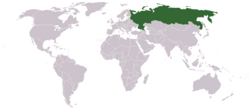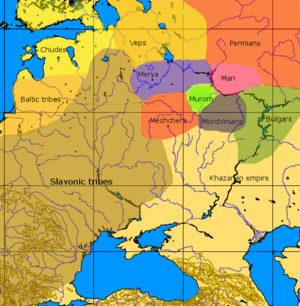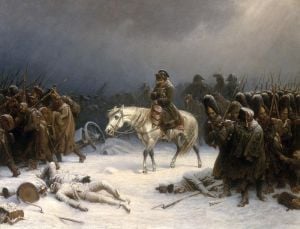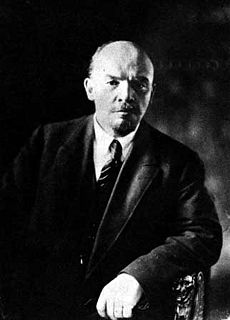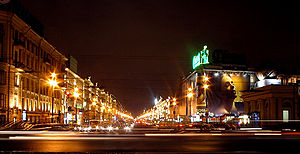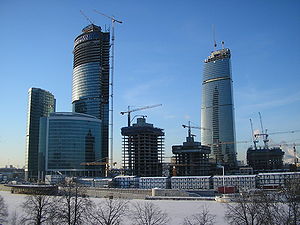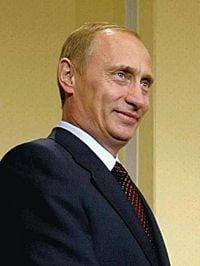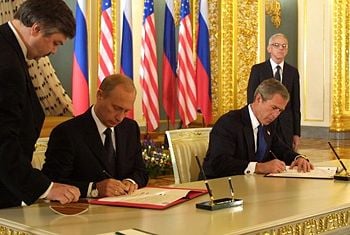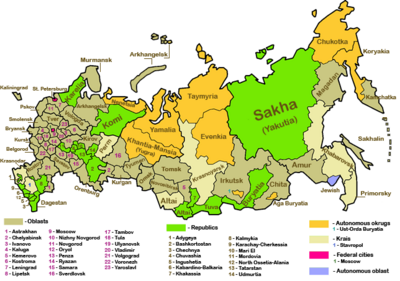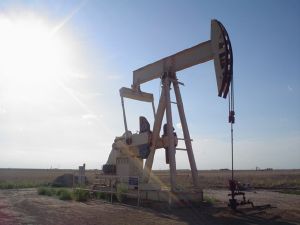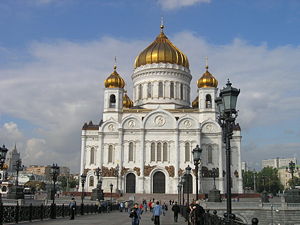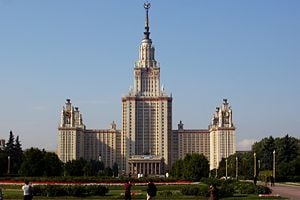Difference between revisions of "Russian Federation" - New World Encyclopedia
Mike Butler (talk | contribs) |
Mike Butler (talk | contribs) |
||
| Line 287: | Line 287: | ||
===Marriage and the family=== | ===Marriage and the family=== | ||
| + | Romantic love is considered the starting point of marriage, although more pragmatic motivations include improving economic status or housing prospects. People meet at school, university, at work, or at discos and clubs. [[Premarital sex]] is accepted, and cohabitation is tolerated, although 97 percent of adults marry by age 40. Every second marriage ends in divorce, resulting from economic hardship, or alcohol abuse. Ethnic [[intermarriage]] became common in the [[Soviet]] era. | ||
| + | |||
| + | Traditionally, the multigenerational extended family characterized peasant life until the twentieth century, and strict patriarchal control over the household was common to all social classes. The communist revolution sought to replace the traditional family with non-authoritarian communal living units, in a short-lived experiment that failed by the end of the 1930s. | ||
| + | |||
| + | The [[nuclear family]] has become the preferred domestic unit. While most married couples want their own apartment, housing shortages and expense mean families often live in apartments holding three generations, with a widowed parent providing child care, food preparation, and money. | ||
| + | |||
| + | During and since the [[Soviet]] period, the most important real property consists of apartments and dachas. Children must be officially registered as residents of those places before the death of the title holder, or the title can revert to the government, although inheritance laws were being reformulated. | ||
| + | |||
| + | Women give birth in crowded maternity hospitals, and stay in the hospital a week after a birth. Government maternity benefits and laws on maternity leave are generous. Infants arel wrapped tightly. Babies are kept very warm. | ||
===Education === | ===Education === | ||
Revision as of 02:31, 19 August 2007
| Российская Федерация Rossiyskaya Federatsiya Russian Federation |
||||||
|---|---|---|---|---|---|---|
|
||||||
| Motto: none | ||||||
| Anthem: Hymn of the Russian Federation |
||||||
| Capital (and largest city) | Moscow 55°45′N 37°37′E | |||||
| Official languages | Russian | |||||
| Government | Semi-presidential Federal republic | |||||
| - | President of Russia | Vladimir Putin | ||||
| - | Prime Minister | Mikhail Fradkov | ||||
| Independence | from the Soviet Union | |||||
| - | Declared | June 12 1991 | ||||
| - | Finalized | December 25 1991 | ||||
| Area | ||||||
| - | Total | 17,075,400 km² (1st) 6,592,800 sq mi |
||||
| - | Water (%) | 13 | ||||
| Population | ||||||
| - | 2006 estimate | 142,400,000 (7th) | ||||
| - | 2002 census | 145,164,000 | ||||
| GDP (PPP) | 2005 estimate | |||||
| - | Total | $1.576 trillion (10th1) | ||||
| - | Per capita | $11,041 (62nd) | ||||
| Currency | Ruble (RUB) |
|||||
| Time zone | (UTC+2 to +12) | |||||
| - | Summer (DST) | (UTC+3 to +13) | ||||
| Internet TLD | .ru (.su reserved) | |||||
| Calling code | +7 | |||||
| 1 Rank based on April 2006 IMF data. | ||||||
- "Russian Federation" redirects here.
- For other uses, see Russian Federation (disambiguation).
Russia (IPA: [ˈɹʌ.ʃə]) (Russian: Росси́я, Rossiya; pronounced [rʌˈsʲi.jə]), also[1] the Russian Federation (Росси́йская Федера́ция, Rossiyskaya Federatsiya; [rʌˈsʲi.skə.jə fʲɪ.dʲɪˈra.ʦɨ.jə],(Russian language) listen ▶), is a transcontinental country extending over much of northern Eurasia (Asia and Europe). With an area of 17,075,400 km², Russia is by far the largest country in the world, covering almost twice the total area of the next-largest country, Canada, and has significant mineral and energy resources.[2] Russia has the world's ninth-largest population. Russia shares land borders with the following countries (counter-clockwise from northwest to southeast): Norway, Finland, Estonia, Latvia, Lithuania, Poland, Belarus, Ukraine, Georgia, Azerbaijan, Kazakhstan, China, Mongolia, and North Korea. It is also close to the United States (the state of Alaska), Sweden, and Japan across relatively small stretches of water (the Bering Strait, the Baltic Sea, and La Pérouse Strait, respectively).
Formerly the Russian Soviet Federative Socialist Republic (RSFSR), a republic of the Union of Soviet Socialist Republics (USSR), Russia became the Russian Federation following the dissolution of the Soviet Union in December 1991. After the Soviet era, the area, population, and industrial production of the Soviet Union (then one of the world's two Cold War superpowers, the other superpower being the United States) that were located in Russia passed on to the Russian Federation.
After the breakup of the Soviet Union, the newly-independent Russian Federation emerged as a great power[3] and is also considered to be an energy superpower. Russia is considered the Soviet Union's successor state in diplomatic matters and is a permanent member of the United Nations Security Council. It is also one of the five recognised nuclear weapons states and possesses the world's largest stockpile of weapons of mass destruction. Russia is the leading nation of the Commonwealth of Independent States, a member of the G8 as well as other international organisations.
Geography and climate

Topography
The two most widely separated points in Russia are about 8,000 km (5,000 mi) apart along a geodesic (i.e. shortest line between two points on the Earth's surface). These points are: the boundary with Poland on a 60-km long (40-mi long) spit of land separating the Gulf of Gdańsk from the Vistula Lagoon; and the farthest southeast of the Kurile Islands, a few miles off Hokkaidō Island, Japan. The points which are furthest separated in longitude are 6,600 km (4,100 mi) apart along a geodesic. These points are: in the West, the same spit; in the East, the Big Diomede Island (Ostrov Ratmanova). The Russian Federation spans eleven time zones.
The Russian Federation stretches across much of the north of the supercontinent of Eurasia. Because of its size Russia displays both monotony and diversity. As with its topography, its climates, vegetation, and soils span vast distances.[4] From north to south the East European Plain is clad sequentially in tundra, coniferous forest (taiga), mixed forest, broadleaf forest, grassland (steppe), and semidesert (fringing the Caspian Sea) as the changes in vegetation reflect the changes in climate.[4] Siberia supports a similar sequence but lacks the mixed forest.[4] Most of Siberia is taiga.[4] Russia has the world's largest forest reserves, which supply lumber, pulp and paper, and raw material for woodworking industries.[5] With access to three of the world's oceans—the Atlantic, Arctic, and Pacific—Russian fishing fleets are a major contributor to the economy.[6] The Caspian is the source of what is considered the finest caviar in the world.[6]
Most of the land consists of vast plains, both in the European part and the part of Asian territory that is largely known as Siberia. These plains are predominantly steppe to the south and heavily forested to the north, with tundra along the northern coast. Mountain ranges are found along the southern borders, such as the Caucasus (containing Mount Elbrus, Russia's and Europe's highest point at 5,642 m / 18,511 ft) and the Altai, and in the eastern parts, such as the Verkhoyansk Range or the volcanoes on Kamchatka. The more central Ural Mountains, a north-south range that form the primary divide between Europe and Asia, are also notable.
Russia has an extensive coastline of over 37,000 kilometres (23,000 mi) along the Arctic and Pacific Oceans, as well as the Baltic, Black and Caspian seas.[7] Some smaller bodies of water are part of the open oceans; the Barents Sea, White Sea, Kara Sea, Laptev Sea and East Siberian Sea are part of the Arctic, whereas the Bering Sea, Sea of Okhotsk and the Sea of Japan belong to the Pacific Ocean. Major islands and archipelagos include Novaya Zemlya, the Franz Josef Land, the New Siberian Islands, Wrangel Island, the Kuril Islands and Sakhalin. (See List of islands of Russia). The Diomede Islands (one controlled by Russia, the other by the United States) are just three kilometers (1.9 mi) apart, and Kunashir Island (controlled by Russia but claimed by Japan) is about twenty kilometres (12 mi) from Hokkaidō.
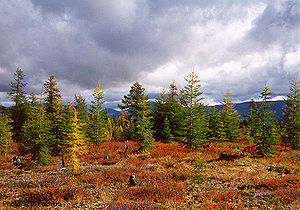
Russia is a water-rich country.[8] Russia has thousands of rivers and inland bodies of water, providing it with one of the world's largest surface-water resources. The most prominent of Russia's bodies of fresh water is Lake Baikal, the world's deepest and most capacious freshwater lake.[9] Lake Baikal alone contains over one fifth of the world's liquid fresh surface water.[9] Truly unique on Earth, Baikal is home to more than 1,700 species of plants and animals, two thirds of which can be found nowhere else in the world.[10] Many rivers flow across Russia; see Rivers of Russia. Of its 100,000 rivers, Russia contains some of the world's longest.[11] The Volga is the most famous — not only because it is the longest river in Europe but also because of its major role in Russian history.[11] Major lakes include Lake Baikal, Lake Ladoga and Lake Onega; see List of lakes in Russia. Russia has a wide natural resource base including major deposits of petroleum, natural gas, coal, timber and many strategic minerals.[7]
Climate
Because of its size, Russia's climate displays both monotony and diversity.[4] The climate of the Russian Federation formed under the influence of several determining factors. One of the most important is the enormous size and remoteness of many areas of the sea, resulting in the dominance of the continental climate. The climates of both European and Asian Russia are continental except for the tundra and the extreme southeast.[4] Mountains in the south obstructing the flow of warm air masses from the Indian Ocean and the plain of the west and north makes the country open to Arctic and Atlantic influences.[12] As a result, much of the territory there are only two distinct seasons - winter and summer; Spring and autumn are usually brief periods of change between extremely low temperatures and extremely high. The coldest month is January (on the shores of the sea - February), the warmest usually is July. Great ranges of temperature are typical.[4] In winter temperatures get colder both from south to north and from west to east.[4] Summers can be quite hot and humid, even in Siberia.[4] A small part of Black Sea coast around Sochi is considered in Russia to have subtropical climate.[13] The continental interiors are the driest areas.[4]
History
Ancient Russia
Prior to the first century, the vast lands of southern Russia were home to scattered tribes, such as Proto-Indo-Europeans[14] and Scythians.[15] Between the third and sixth centuries, the steppes were overwhelmed by successive waves of nomadic invasions,[16] led by warlike tribes which would often move on to Europe, as was the case with Huns and Turkish Avars.
During the period from fifth century B.C.E. to seventh century human settlements are represented by Dyakovo culture of Iron Age which occupies the significant part of the Upper Volga, Valday and Oka River area. Dyakovo culture was formed by Finno-Ugric peoples, ancestors of Merya, Muromian, Meshchera, Veps tribes. All regional Funno-Ugric toponymy and hydronym names go back to those languages, for example Yauza River which is a confluent of the Moskva River, and probably the Moskva River itself too.
A Turkic people, the Khazars, reigned the lower Volga basin steppes between the Caspian and Black Seas through the 8th century.[17] Noted for their laws, tolerance, and cosmopolitanism,[18] the Khazars were the main commercial link between the Baltic and the Muslim Abbasid empire centered in Baghdad.[19] They were important allies of the Byzantine Empire,[20] and waged a series of successful wars against the Arab Caliphates.[21][17]

In this era, the term "Rhos" or "Rus" first came to be applied to the Varangians and later also to the Slavs who peopled the region.[22] As well as one of the rulers who contributed to the name "rus". In the tenth to eleventh centuries this state of Kievan Rus became the largest in Europe and one of the most prosperous, due to diversified trade with both Europe and Asia. The opening of new trade routes with the Orient at the time of the Crusades contributed to the decline and fragmentation of Kievan Rus by the end of the twelfth century.
In the eleventh and twelfth centuries, the constant incursions of nomadic Turkish tribes, such as the Kipchaks and the Pechenegs, led to the massive migration of Slavic populations from the fertile south to the heavily forested regions of the north, known as Zalesye. The medieval states of Novgorod Republic and Vladimir-Suzdal emerged as successors to Kievan Rus on those territories, while the middle course of the Volga River came to be dominated by the Muslim state of Volga Bulgaria. Like many other parts of Eurasia, these territories were overrun by the Mongol invaders, who formed the state of Golden Horde which would pillage the Russian principalities for over three centuries. About half of the Russian population died during the Mongol invasion.[23] Later known as the Tatars, they ruled the southern and central expanses of present-day Russia, while the territories of present-day Ukraine and Belarus were incorporated into the Grand Duchy of Lithuania and Poland, thus dividing the Russian people in the north from the Belarusians and Ukrainians in the west.
Similarly to the Balkans, long-lasting nomadic rule retarded the country's economic and social development. However, the Novgorod Republic together with Pskov retained some degree of autonomy during the time of the Mongol yoke and was largely spared the atrocities that affected the rest of the country. Led by Alexander Nevsky, the Novgorodians repelled the Germanic crusaders who attempted to colonise the region.
Muscovy
Unlike its spiritual leader, the Byzantine Empire, Russia under the leadership of Moscow was able to revive and organise its own war of reconquest, finally subjugating its enemies and annexing their territories. After the fall of Constantinople in 1453, Muscovite Russia remained the only more or less functional Christian state on the Eastern European frontier, allowing it to claim succession to the legacy of the Eastern Roman Empire. While still under the domain of the Mongol-Tatars and with their connivance, the duchy of Moscow began to assert its influence in Western Russia in the early fourteenth century. Assisted by the Russian Orthodox Church and Saint Sergius of Radonezh's spiritual revival, Muscovy inflicted a defeat on the Mongol-Tatars in the Battle of Kulikovo (1380). Ivan the Great eventually tossed off the control of the invaders, consolidated surrounding areas under Moscow's dominion and first took the title "grand duke of all the Russias".
In the beginning of the sixteenth century, the Russian state set the national goal to return all Russian territories lost as a result of the Tatar invasion and to protect the southern borderland against attacks of Crimean Tatars and other Turkic peoples. The noblemen, receiving a manor from the sovereign, were obliged to serve in the military. The manor system became a basis for the nobiliary horse army. In 1547, Ivan the Terrible was officially crowned the first Tsar of Russia. During his long reign, Ivan annexed the Tatar khanates (Kazan, Astrakhan) along the Volga River and transformed Russia into a multiethnic and multiconfessional state. By the end of the century, Russian Cossacks established the first Russian settlements in Western Siberia. But his rule was also marked by the atrocities against both the nobility and the common people on vast scale which eventually, after his death, led to the civil war of the Time of Troubles in early 1600s. In the middle of the seventeenth century there were Russian settlements in Eastern Siberia, on Chukchi Peninsula, along the Amur River, on the Pacific coast, and the strait between North America and Asia was first sighted by a Russian explorer in 1648. The colonisation of the Asian territories was largely peaceful, in sharp contrast to the build-up of other colonial empires of the time.
Imperial Russia
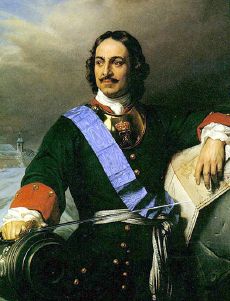
Muscovite control of the nascent nation continued after the Polish intervention under the subsequent Romanov dynasty, beginning with Tsar Michael Romanov in 1613. Peter the Great (ruled in) defeated Sweden in the Great Northern War, forcing it to cede Ingria, Estland, and Livland (the two latter now being Estonia and northern Latvia). It was in Ingria that he founded a new capital, Saint Petersburg. Peter succeeded in bringing ideas and culture from Western Europe to a severely underdeveloped Russia. After his reforms, Russia emerged as a major European power. Catherine the Great, ruling from 1762 to 1796, continued the Petrine efforts at establishing Russia as one of the great powers of Europe. Examples of its eighteenth-century European involvement include the War of Polish Succession and the Seven Years' War. In the wake of the Partitions of Poland, Russia had acquired significant territories in the west. As a result of the victorious Russian-Turkish wars, Russia's borders expanded to the Black Sea and Russia set its goal on the protection of Balkan Christians against a Turkish yoke. In 1783, Russia and the Georgian Kingdom (which was almost totally devastated by Persian and Turkish invasions) signed the treaty of Georgievsk according to which Georgia received the protection of Russia.
In 1812, having gathered nearly half a million soldiers from France as well as from all of its conquered states in Europe, Napoleon invaded Russia but, after taking Moscow, was forced to retreat back to France. Almost 90%[24][25] of the invading forces died as a result of on-going battles with the Russian army, guerrillas and winter weather. The Russian armies ended their pursuit of the enemy by taking his capital, Paris. The officers of the Napoleonic wars brought back to Russia the ideas of liberalism and even attempted to curtail the tsar's powers during the abortive Decembrist revolt (1825), which was followed by several decades of political repression. Another result of the Napoleonic wars was the incorporation of Bessarabia, and Finland into the Russian Empire, and creation of the Congress Poland. The perseverance of Russian serfdom and the conservative policies of Nicholas I of Russia impeded the development of Imperial Russia in the mid-nineteenth century. As a result, the country was defeated in the Crimean War, 1853–1856, by an alliance of major European powers, including Britain, France, Ottoman Empire, and Piedmont-Sardinia. Nicholas's successor Alexander II (1855–1881) was forced to undertake a series of comprehensive reforms and issued a decree abolishing serfdom in 1861. The Great Reforms of Alexander's reign spurred increasingly rapid capitalist development and Sergei Witte's attempts at industrialisation. The Slavophile mood was on the rise, spearheaded by Russia's victory in the Russo-Turkish War, which forced the Ottoman Empire to recognise the independence of Romania, Serbia and Montenegro and autonomy of Bulgaria.
The failure of agrarian reforms and suppression of the growing liberal intelligentsia were continuing problems however, and on the eve of World War I, the position of Tsar Nicholas II and his dynasty appeared precarious. The Russian government did not want war in 1914 but felt that the only alternative was acceptance of German domination of Europe.[26] Upper- and middle-class Russians rallied around the regime’s war effort.[26] Peasants and workers were much less enthusiastic.[26] Germany was Europe’s leading military and industrial power, and Austria and the Ottoman Empire were its allies in the war.[26] Consequently, Russia was forced to fight on three fronts and was isolated from its French and British war partners.[26] Under these circumstances the Russian war effort was impressive.[26] Having won a number of major battles in 1916, the army was far from defeated when the Russian Revolution of 1917 broke out in February.[26] The home front collapsed under the strains of war, partly for economic reasons but primarily because the already existing public distrust of the regime was deepened by tales of inefficiency, corruption, and even treason in high places.[26] Many of these tales were nonsense or grossly exaggerated, such as the belief that a semiliterate mystic, Grigory Rasputin, had great political influence within the government.[26] What mattered, however, was that the rumors were believed.[26] At the close of the Russian Revolution of 1917, a Marxist political faction called the Bolsheviks seized power in Petrograd and Moscow under the leadership of Vladimir Lenin. The Bolsheviks changed their name to the Communist Party. A bloody civil war ensued, pitting the Bolsheviks' Red Army against a loose confederation of anti-socialist monarchist and bourgeois forces known as the White Army. The Treaty of Brest-Litovsk, a peace treaty signed by the Central Powers with Soviet Russia, concluded hostilities between those countries in World War I. Russia lost the Ukraine, its Polish and Baltic territories, and Finland by signing the treaty, which was later annulled by the Armistice. Following the defeat of the Central Powers and the Armistice treaty, these states became independent, but were later incorporated into the Soviet Union, which effectively covered the same territory that Russia did before the Treaty of Brest-Litovsk. The Red Army triumphed in the Civil War, and the Soviet Union was formed in 1922.
Soviet Russia
After a failed Bolshevik rising in July 1917, Lenin fled to Finland for safety. Here he wrote "State and Revolution",[27] which called for a new form of government based on workers' councils, or soviets elected and revocable at all moments by the workers. He returned to Petrograd in October, inspiring the October Revolution with the slogan "All Power to the Soviets!". Lenin directed the overthrow of the Provisional Government from the Smolny Institute from the 6th to the 8th of November 1917. The storming and capitulation of the Winter Palace on the night of the 7th to 8th of November marked the beginning of Soviet rule. On November 8, 1917, Lenin was elected as the Chairman of the Council of People's Commissars by the Russian Congress of Soviets. Lenin emphasised the importance of bringing electricity to all corners of Russia and modernising industry and agriculture. He was very concerned about creating a free universal health care system for all, the rights of women, and teaching all Russian people to read and write.[28] On December 301922, the Russian SFSR together with three other Soviet republics formed the Soviet Union.[29]
The Soviet Union was meant to be a trans-national worker's state free from nationalism.[citation needed] The concept of Russia as a separate national entity was therefore not emphasised in the early Soviet Union.[citation needed] However, people and leaders around the world often referred to the Soviet Union as "Russia" and its people as "Russians". The Russian Soviet Federated Socialist Republic dominated the Soviet Union for its entire 74-year history.[30] The Russian Federation was by far the largest of the republics; Moscow, its capital, was also the capital of the Soviet Union.[30] Although Russian institutions and cities certainly remained dominant, non-Russians participated in the new government at all levels. After Lenin's death in 1924, a brief power struggle ensued, during which a top communist official, a Georgian named Joseph Stalin, gradually eroded the various checks and balances which had been designed into the Soviet political system and assumed dictatorial power by the end of the decade.[29]
1927-1953
Stalin forced rapid industrialisation of the largely rural country and collectivisation of its agriculture. In 1928, Stalin introduced his First Five Year Plan for modernising the Soviet economy.[31] Most economic output was immediately diverted to establishing heavy industry. Civilian industry was modernised and many heavy weapon factories were established. The plan worked, in some sense, as the Soviet Union successfully transformed from an agrarian economy to a major industrial powerhouse in an unbelievably short span of time, but widespread misery and famine ensued for many millions of people as a result of the severe economic upheaval.
Almost all Old Bolsheviks from the time of the Revolution, including Leon Trotsky, were killed or exiled. At the end of 1930s, Stalin launched the Great Purges, a massive series of political repressions. Millions of people whom Stalin and local authorities suspected of being a threat to their power were executed or exiled to Gulag labor camps in remote areas of Siberia or Central Asia. A number of ethnic groups in Russia and other republics were also forcibly resettled during Stalin's rule.
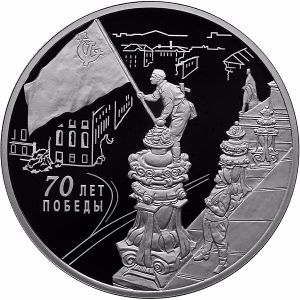

The defensive war of the Soviet Union against Nazi Germany, part of the World War II known in the Soviet Union and Russia as the Great Patriotic War, started with the German invasion of the Soviet Union on June 221941. It was the largest theatre of war in history and was notorious for its unprecedented ferocity, destruction, and immense loss of life. The fighting involved millions of German and Soviet troops along a broad front. It was by far the deadliest single theatre of war in World War II, with over 5.5 million deaths on the Axis Forces; Soviet military deaths were about 8.6 million (out of which 2.8 - 3.3 million Soviet prisoners of war (of 5.5 million) died in German captivity),[32][33][34] and civilian deaths were about 14 to 18 million. The Eastern Front contained more combat than all the other European fronts combined; the German army suffered 80% to 93% of all casualties there.[35][36] The fate of the Third Reich was decided at Stalingrad and sealed at Kursk. The German army had considerable success in the early stages of the campaign, but they suffered defeat when they reached the outskirts of Moscow. The Red Army then stopped the Nazi offensive at the Battle of Stalingrad in the winter of 1942-43, which became the decisive turning point for Germany's fortunes in the war. The Soviets drove through Eastern Europe and captured Berlin before Germany surrendered in 1945. During the war, the Soviet Union lost around 27 million citizens [37][38] (including up to 18 million civilians), about half of all World War II casualties.
Although ravaged by the war, the Soviet Union emerged from the conflict as an acknowledged superpower. The Red Army occupied Eastern Europe after the war, including the eastern half of Germany. Stalin installed loyal communist governments in these satellite states. During the immediate postwar period, the Soviet Union first rebuilt and then expanded its economy, with control always exerted exclusively from Moscow. The Soviets extracted heavy war reparations from the areas of Germany under their control, mostly in the form of machinery and industrial equipment. The Soviet Union consolidated its hold on Eastern Europe (see Eastern bloc) and entered a long struggle with the United States and Western Europe on economic, political, and ideological dominance over the Third World. The ensuing struggle became known as the Cold War, which turned the Soviet Union's wartime allies, Britain and the United States, into its foes.
1953-1985
Under Khrushchev, the Soviet Union launched the world's first artificial satellite, Sputnik 1, and the Soviet cosmonaut Yuri Gagarin became the first human to orbit the Earth aboard the first manned spacecraft, Vostok 1. The space race produced rapid advances in rocketry, material science, computers, and many other areas. Khrushchev's reforms in agriculture and administration, however, were generally unproductive. Foreign policy toward China and the United States suffered reverses, notably the Cuban Missile Crisis, when Khrushchev began installing nuclear missiles in Cuba (after the United States installed Jupiter missiles in Turkey, which nearly provoked a war with the Soviet Union). Following the ousting of Khrushchev, another period of rule by collective leadership ensued until Leonid Brezhnev established himself in the early 1970s as the pre-eminent figure in Soviet politics. Brezhnev is frequently derided by historians for stagnating the development of the Soviet Union (see "Brezhnev stagnation"). Others have acknowledged that despite its inertia and repression (though very mild relative to the Stalin years), the Brezhnev era did offer a relative prosperity to a populace and leadership battered by decades of war, famine, collectivisation and crash industrialisation, deadly political crises, arbitrary mass murder and arrest, and the volatility of the Khrushchev years. In 1979 the troubled nine-year Soviet war in Afghanistan began.
1985-1991
Following the short rules of Yury Andropov and Konstantin Chernenko, in 1985, the reform-minded[39] Mikhail Gorbachev came to power. He introduced the landmark policies of glasnost (openness) and perestroika (restructuring), in an attempt to modernise Soviet communism. Glasnost meant that the harsh restrictions on free speech that had characterised most of the Soviet Union's existence were alleviated, and open political discourse and criticism of the government became possible again. Perestroika meant sweeping economic reforms designed to decentralise the planning of the Soviet economy. However, the Stalinist system was probably beyond repair, and the Gorbachev reforms started in motion forces of change that demonstrated that meaningful reform would eventually threaten Communist Party hegemony. His initiatives also provoked strong resentment amongst conservative elements of the government, and in August of 1991 an unsuccessful military coup that attempted to remove Gorbachev from power instead led to the collapse of the Soviet Union. Boris Yeltsin came to power and declared the end of exclusive Communist rule. The USSR splintered into fifteen independent republics, and was officially dissolved in December of 1991. Prior to the dissolution of the Soviet Union, Boris Yeltsin had been elected President of Russia in June 1991 in the first direct presidential election in Russian history. In October 1991, as Russia was on the verge of independence, Yeltsin announced that Russia would proceed with radical market-oriented reform along the lines of "shock therapy".[40]
Post-Soviet Russia
After the disintegration of the USSR, the Russian economy went through a crisis.[41] Russia took up the responsibility for settling the USSR's external debts, even though its population made up just half of the population of the USSR at the time of its dissolution.[42] The largest state enterprises (petroleum, metallurgy, and the like) were controversially privatised by President Boris Yeltsin to insiders[43] (who became billionaires virtually overnight) for far less than they were worth, while the majority of the population plunged into poverty.[40] Corruption has run rampant,[44] and the Yeltsin government has been accused of conspiring with insiders to loot countless billions in cash and assets from the State[45] (for example, Yeltsin's son-in-law became the CEO of Aeroflot, Russia's largest airline).
The 1990s were plagued by armed ethnic conflicts in the North Caucasus.[40] Such conflicts took a form of separatist Islamist insurrections against federal power (most notably in Chechnya), or of ethnic/clan conflicts between local groups (e.g., in North Ossetia-Alania between Ossetians and Ingushs, or between different clans in Chechnya).[40] Since the Chechen separatists declared independence in the early 1990s, an intermittent guerrilla war (First Chechen War, Second Chechen War) has been fought between disparate Chechen groups and the Russian military.[40] Russia has severely disabled the Chechen rebel movement, although sporadic violence still occurs throughout the North Caucasus.[7]
After Yeltsin's presidency in the 1990s, the recently appointed Prime Minister (who was also head of the FSB from July 1998 through August 1999) Vladimir Putin was elected in 2000. High oil prices and growing internal demand boosted Russian economic growth, stimulating significant economic expansion abroad and helping to finance increased military spending.[40] Putin's presidency has shown improvements in the Russian standard of living, as opposed to the 1990s.[40][47] Under Putin, the economy developed significantly and currently Russia enjoys a state of rapid economical growth, averaging 6.7% annual GDP growth for the past 8 straight years.[7]
Government and politics
The politics of the Russian Federation take place in a framework of a federal presidential republic.According to the Constitution of Russia, the president is head of state, and of a pluriform multi-party system with executive power exercised by the government, headed by the prime minister, who is appointed by the president by the parliament's approbation. Legislative power is vested in the two chambers of the federal assembly, while the president and the government issue numerous legally binding by-laws. Although Russia has traditionally been ruled by absolute monarchs and dictators, in 2007 it had a democratic system of government.
Structure
For the executive, the president is elected by popular vote for a four-year term and is eligible for a second term. An election was last held in March 2004. Vladimir Putin has been acting president since December 1999, and president since May 2000. The president appoints a cabinet comprising the premier and his deputies, ministers, and selected other individuals.
The legislature, termed the Federal Assembly or Federalnoye Sobraniye, consists of two chambers, the 450-member State Duma or Gosudarstvennaya Duma and the 178-member Federation Council or Sovet Federatsii.
Duma members are put forward from party lists on a basis of proportional representation. A party gains representation by winning at least five percent of the vote to serve four-year terms. There are 225 party list seats, and 225 seats representing electorates. Duma elections were last held in December 2003. Sobraniye members are appointed by the top executive and legislative officials in each of the 88 federal administrative units - oblasts, krays, republics, autonomous okrugs and oblasts, and the federal cities of Moscow and Saint Petersburg, to serve four-year terms. United Russia won 37.1 percent of the vote in 2003, CPRF 12.7 percent, LDPR 11.6 percent,, Motherland 9.1 percent, and other 29.5 percent.
The Russian judiciary is divided into three branches: The courts of general jurisdiction (including military courts); subordinated to the Supreme Court; the arbitration (commercial) court system under the High Court of Arbitration; and the Constitutional Court (as well as constitutional courts in a number of administrative entities of the Russian Federation). Civil and criminal cases are tried in courts of primary jurisdiction, courts of appeals, and higher courts. The general court system's lowest level is the municipal court, which serves each city or rural district and hears more than 90% of all civil and criminal cases. The next level of courts of general jurisdiction is the regional courts. At the highest level is the Supreme Court. Judges for all courts are appointed for life by the Federation Council on the recommendation of the president.
The legal system is based on civil law system, there is judicial review of legislative acts, and the Russian Federation has not accepted compulsory ICJ jurisdiction. Constitutional justice is based on the equality of all citizens. Judges are independent and subject to the law. Trials are to be open, and the accused is guaranteed a defense.
Constitutional challenges
Since gaining its independence with the collapse of the Soviet Union at the end of 1991, Russia has faced serious challenges in its efforts to forge a political system to follow nearly 75 years of Soviet rule. For instance, leading figures in the legislative and executive branches have put forth opposing views of Russia's political direction and the governmental instruments that should be used to follow it. That conflict reached a climax in September and October 1993, when President Boris Yeltsin used military force to dissolve the parliament and called for new legislative elections. This event marked the end of Russia's first constitutional period, which was defined by the much-amended constitution adopted by the Russian Republic in 1978. |A new constitution, creating a strong presidency, was approved by referendum in December 1993.
With a new constitution and a new parliament representing diverse parties and factions, Russia's political structure subsequently showed signs of stabilization. As the transition period extended into the mid-1990s, the power of the national government continued to wane as Russia's regions gained political and economic concessions from Moscow. Although the struggle between executive and legislative branches was partially resolved by the new constitution, the two branches continued to represent fundamentally opposing visions of Russia's future. Most of the time, the executive was the center of reform, and the lower house of the parliament, the State Duma, was a bastion of antireform communists and nationalists.
Foreign relations
The Russian Federation (Russia) is recognised in international law as continuing the legal personality of the former Soviet Union. The Russian Federation continues to implement the international commitments of the USSR, and has assumed the USSR's permanent seat on the UN Security Council, membership in other international organisations, the rights and obligations under international treaties and property and debts. Russia is one of the key players in international relations. As one of five permanent members of the UN Security Council, Russia has a special responsibility for maintaining international peace and security.
Since 1994, Russia has participated as a member of the Group of Eight (G8) industrialised nations, although the Finance Ministers/Secretaries of Finance and Leaders of the G7 central banks continue to meet several times a year, without their Russian counterparts. Russia is a member of the Council of Europe and OSCE. Russia takes a special role in the organisations created on the territory of the former USSR, largely under the leadership of Russia : CIS, EurAsEC, CSTO, SCO.
The collapse of the Soviet Union has also resulted in Russia becoming a somewhat more NATO-friendly country and the establishment of the NATO-Russia Council, which brings together the NATO members and the Russian Federation; however, Russia has not formally joined the NATO as an ally, nor has Russia expressed any desire to join NATO.
Russia has a multifaceted foreign policy. It maintains diplomatic relations with 178 countries and has 140 embassies. Russia's foreign policy is determined by the President and implemented by the Ministry of Foreign Affairs.
Subdivisions
The Russian Federation comprises 85 federal subjects, namely:
- 47 oblasts (provinces)
- 21 republics (states) which enjoy a high degree of autonomy on most issues and which correspond to some of Russia's numerous ethnic minorities
- eight krais (territories)
- six okrugs (autonomous districts)
- two federal cities (Moscow and St. Petersburg)
- the Jewish Autonomous Oblast.
Federal subjects are grouped into seven federal districts, each administered by an envoy appointed by the President of Russia. Unlike the federal subjects, the federal districts are not a sub-national level of government, but are a level of administration of the federal government. Federal districts' envoys serve as liaisons between the federal subjects and the federal government and are primarily responsible for overseeing the compliance of the federal subjects with the federal laws.
For economic and statistical purposes the federal subjects are grouped into 12 economic regions. Economic regions and their parts sharing common economic trends are in turn grouped into economic zones and macrozones.
Military
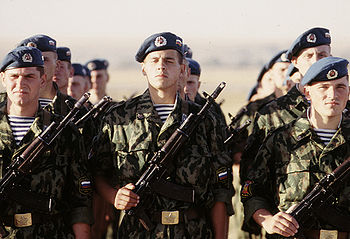
After the dissolution of the USSR, in 1991, Russia assumed control of Soviet assets abroad, and received the lion's share of the Soviet Union's production facilities and military forces. About 70 percent of the former Soviet Union's defense industries are located in the Russian Federation.
The Russian military is divided into the Ground Forces, Navy, and Air Force. There are also three independent arms of service: Strategic Rocket Forces, Military Space Forces, and the Airborne Troops. Russia ranks at or near the top of many metrics of military power including in numbers of tanks, fighter aircraft and naval vessels; it has the largest stockpile of nuclear weapons. It also has the second largest fleet of ballistic missile submarines, and is the only country apart from the U.S. with a modern strategic bomber force. As of 2005, 330,000 men are brought into the army via conscription annually, though the Army in 2007 was phasing out conscription altogether.
Defence spending is consistently increasing by at least a minimum of one-third year on year, leading to overall defence expenditure almost quadrupling over the past six years, and according to Finance Minister Alexei Kudrin, this rate is to be sustained through 2010.Official government military spending for 2007 was $32.4 billion, though various sources, including the US Department of Defense, have estimated Russia’s military expenditures to be considerably higher than the reported amount. By some estimates, overall Russian defence expenditure is now at the second highest in the world after the USA. The recent steps towards modernisation of the Armed Forces has been made possible by Russia's spectacular economic resurgence based on oil and gas revenues as well a strengthening of its own domestic market. Currently, the military is in the middle of a major equipment upgrade, with the government in the process of spending about $200-billion (what equals to about $400-billion in PPP dollars) on development and production of military equipment between 2006-2015. Russia is the world's top supplier of weapons, a spot it has held since 2001, accounting for around 30% of worldwide weapons sales. Russia is the principal weapons supplier of China and India, and provides weapons to Iran, Algeria, Venezuella and other countries. Recent arms deals seem to show that Russia is building on its former influence, both in the Middle East and in Latin America.
Economy
More than a decade after the collapse of the Soviet Union in 1991, Russia is trying to further develop a market economy and achieve much more consistent economic growth. Russia saw its comparatively developed centrally planned economy contract severely for five years, as the executive and the legislature dithered over the implementation of reforms and Russia's aging industrial base faced a serious decline.[48] However, Russia's economy has adapted relatively quickly from the world's largest centrally planned economy to a market economy. Russia ended 2006 with its eighth straight year of growth, averaging 6.7% annually since the financial crisis of 1998. Although high oil prices and a relatively cheap ruble initially drove this growth, since 2003 consumer demand and, more recently, investment have played a significant role.[7] Over the last five years, fixed capital investments have averaged real gains greater than 10% per year and personal incomes have achieved real gains more than 12% per year.[7] During this time, poverty has declined steadily and the middle class has continued to expand.[7] Russia has also improved its international financial position since the 1998 financial crisis.[7] The federal budget has run surpluses since 2001 and ended 2006 with a surplus of 9% of GDP.[7] Over the past several years, Russia has used its stabilization fund based on oil taxes to prepay all Soviet-era sovereign debt to Paris Club creditors and the IMF.[7] Oil export earnings have allowed Russia to increase its foreign reserves from $12 billion in 1999 to some $315 billion at yearend 2006, the third largest reserves in the world (currently it stands at $420.2 billion)[49].[7]
Russia's 2006 GDP was $1.723 trillion (est. PPP), the 9th highest in the world, with GDP growth of 6.8%. Growth was driven by non-tradable services and goods for the domestic market, as opposed to oil or mineral extraction and exports.[7] The Russian economy has once again outperformed expectations, and the International Monetary Fund forecasts that Russia's GDP will grow 7% in 2007.[50]
The economic development of the country has been extremely uneven geographically: the Moscow region contributes one-third of the country's GDP while having only a tenth of its population.[40] While the huge capital region of Moscow is an affluent metropolis, much of the country, especially indigenous and rural communities in Asia, lags significantly behind.
According to the Federal State Statistics Service of Russia, the monthly nominal average salary in January 2007 was 11,410 rubles (about $437 nominally; about $793 PPP), 26.6 percent higher than in January 2006.[51]
Russia's macroeconomic performance in recent years has been impressive. High oil prices and large capital inflows have contributed importantly to this success, but a principal factor has been the combination of strong growth in productivity, real wages, and consumption.[52] Very high levels of education and societal involvement achieved by the majority of the population, including women and minorities, secular attitudes, mobile class structure, and better integration of various minorities into the mainstream culture set Russia far apart from the majority of the so-called developing countries and even some developed nations.[40]
The country is also benefiting from rising oil prices and has been able to very substantially to reduce its formerly huge foreign debt.[53] However, equal redistribution of capital gains from the natural resource industries to other sectors is still a problem.[40] Nonetheless, since 2003, exports of natural resources started decreasing in economic importance as the internal market has strengthened considerably, largely stimulated by intense construction, as well as consumption of increasingly diverse goods and services.[40]
Knowing the importance of oil and gas to the economy, the Stabilization Fund of the Russian Federation was formed by the government in January 2004.[54] This fund takes in revenues from oil and gas exports and is designed to help offset oil market volatility.[54] Russia has the largest known natural gas reserves of any state on Earth, along with the second largest coal reserves, and the eighth largest oil reserves. It is the world's second largest oil producer.[55] Currently, its economy benefits greatly from the relatively high price of oil.
Demographics
Population
Though Russia's population is large, at 145,164,000 in 2006, its average population density is low because of its enormous size. Its population is densest in European Russia, near the Ural Mountains, and in the southwest Siberia. About 75 percent of the population live in urban areas. As of the 2002 Census, the two largest cities in Russia are Moscow (10,342,151 inhabitants) and Saint Petersburg (4,661,219). Eleven other cities had between one and two million inhabitants: Chelyabinsk, Kazan, Novosibirsk, Nizhny Novgorod, Omsk, Perm, Rostov-on-Don, Samara, Ufa, Volgograd, and Yekaterinburg.
Health
Russia's constitution guarantees free, universal health care for all Russian citizens. While Russia has more physicians, hospitals, and health care workers than almost any other country in the world, it has struggled to provide high levels of health care services. In the past decade, the health of the Russian population has declined considerably, a result of social, economic, and lifestyle changes. Life expectancy for the total population was 65.87 years in 2007 — 59.12 years for males, 73.03 years for females. The biggest factor contributing to this relatively low life expectancy is a high mortality rate among working-age males due to preventable causes (e.g., alcohol, smoking, traffic accidents, violent crimes). In 2006, the federal statistics agency reported that Russia's population shrunk by about 700,000 people, dipping to 142.8 million. The primary causes of Russia's population decrease are a high death rate and low birth rate. Heart disease claims proportionately more lives than in most of the rest of the world. Death rates from homicide, suicide, auto accidents and cancer are also especially high. Smoking also contributes to the demographic crisis, with more than 300,000 lives lost each year as a result of tobacco use.
In an effort to stem Russia’s demographic crisis, in 2006 the government doubled monthly child support payments and offered a one-time payment of US$9200 to women who had a second child. Russia is the second country in the world by the number of immigrants from abroad, mostly from the former Soviet Union, and immigration is increasingly seen as necessary to sustain the country's population.
Ethnicity
The Russian Federation is home to as many as 160 different ethnic groups and indigenous peoples. As of the 2002 Russian census, 79.8 percent of the population is ethnically Russian, 3.8 percent Tatar, 2 percent Ukrainian, 1.2 percent Bashkir, 1.1 percent Chuvash, 0.9 percent Chechen, 0.8 percent Armenian, and 10.3 percent other or unspecified. Nearly all groups besides Russians live compactly in their respective regions. Ethnic relations are stressed with tension resulting from centuries of Russian and Soviet domination and were activated by the collapse of the Soviet state. Conflicts center on political control, rights to natural resources, relocation of ethnic groups, and the revitalization of ethnic cultures, religions, languages, and identities. The Soviet regime compelled the use of the Russian language, forcibly relocated whole populations, installed ethnic Russian political elites in non-Russian regions, and drained regional resources.
Religion
Christianity, Islam, Buddhism, and Judaism are Russia’s traditional religions. Estimates of the number of believers range from 85-90 percent (all non-atheists) to 7-15 percent (all of the people who attend worship at least once a month). Estimates of believers widely fluctuate between sources, and some reports put the number of non-believers in Russia as high as 24-48 percent of the population. The ancestors of today’s Russians adopted Orthodox Christianity in the 10th century. The majority of Russian citizens, and as many as 80 percent of ethnic Russians, self-identify as Russian Orthodox. According to the Russian Public Opinion Research Center, 63 percent of respondents consider themselves Russian Orthodox. This makes the Russian Orthodox Church by far the most widespread religion. However, the vast majority of Orthodox believers do not attend church on a regular basis. The percentage of Russians who attend church services on a weekly basis was estimated by the Interior Ministry to be less than 2 percent. Nonetheless, the church is widely respected by both believers and nonbelievers, who see it as a symbol of Russian heritage and culture. Small numbers of other Christian demoninations exist. The number of Roman Catholics is estimated to be approximately 400,000 to 500,000; Armenian Gregorian, about 1.2 million; and Protestants, about 1 million.
Russia has from 10 to 20 million Muslims, constituting the largest religious minority. Most Muslims live in the Volga-Ural region, as well as in the North Caucasus, Moscow, St. Petersburg and western Siberia. In Russia there are more than 6000 mosques (in 1991 it was about 100). A particularly large number of Muslims live in rural areas, mainly in the Caucasus. According to the Federation of Jewish Communities of Russia, the number of Jews in Russia is about 1.5 million. Of these, according to the Federation of Jewish Communities of Russia, Moscow is home to some 500,000 Jews, and St. Petersburg about 170,000. In Russia there are about 70 synagogues.
Buddhism is traditional for three regions of the Russian Federation: Buryatia, Tuva and Kalmykia. According to the Buddhist Association of Russia, the number of people practising Buddhism is 1.5 to 2 million. Some residents of the Siberian and Far Eastern regions, Yakutia, Chukotka, etc., practice pantheistic and pagan rites, along with the major religions.
Induction into religion takes place primarily along ethnic lines. Ethnic Russians are mainly Orthodox whereas most people of Turkic extraction are Sunni Muslim. On the other hand, the New Age movement has led to emergence of some "non-traditional" religions in large cities. On May 17, 2007, an Act of Canonical Communion was signed between the Moscow Patriarchate of the Russian Orthodox Church and the Russian Orthodox Church Outside Russia.
Language
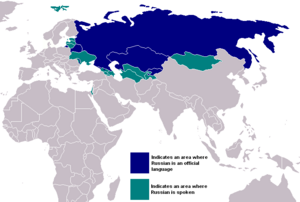
Russian is the only official state language, but the individual republics have often made their native language co-official next to Russian. The Cyrillic alphabet is the only official script, which means that these languages must be written in Cyrillic in official texts. Russian is the most geographically widespread language of Eurasia and the most widely spoken of the Slavic languages.
Russian belongs to the family of Indo-European languages and is one of three living members of the East Slavic languages; the others being Belarusian and Ukrainian (and possibly Rusyn, often considered a dialect of Ukrainian). The roots of the Russian language are some 3000 to 4000 years old. Written examples of Old East Slavonic are attested from the 10th century onwards.
While Russian preserves much of East Slavonic grammar and a Common Slavonic word base, modern Russian exhibits a large stock of borrowed international vocabulary for politics, science, and technology. Due to the status of the Soviet Union as a superpower, Russian had great political importance in the twentieth century. Hence, the language is still one of the official languages of the United Nations.
Men and women
Traditionally, newly married women were subservient in the families of their husbands until they had borne sons. Under communist ideology, which aimed to free women from oppressive norms, women were trained to take up men’s work, such as operating agricultural machinery, working in construction, and working on roads and railways. Nurseries and day care centers were set up to free women from child rearing. Soviet women gained authority and status in medicine and education, and increased political representation. But as unemployment grew in the 1990s, women were the first to lose their jobs. As a traditionalist view of work and family reappeared, some women whose husbands had succeeded in the new economy were glad to become full-time mums. Fewer women hold political office, and significant numbers of young women have been lured into prostitution.
Marriage and the family
Romantic love is considered the starting point of marriage, although more pragmatic motivations include improving economic status or housing prospects. People meet at school, university, at work, or at discos and clubs. Premarital sex is accepted, and cohabitation is tolerated, although 97 percent of adults marry by age 40. Every second marriage ends in divorce, resulting from economic hardship, or alcohol abuse. Ethnic intermarriage became common in the Soviet era.
Traditionally, the multigenerational extended family characterized peasant life until the twentieth century, and strict patriarchal control over the household was common to all social classes. The communist revolution sought to replace the traditional family with non-authoritarian communal living units, in a short-lived experiment that failed by the end of the 1930s.
The nuclear family has become the preferred domestic unit. While most married couples want their own apartment, housing shortages and expense mean families often live in apartments holding three generations, with a widowed parent providing child care, food preparation, and money.
During and since the Soviet period, the most important real property consists of apartments and dachas. Children must be officially registered as residents of those places before the death of the title holder, or the title can revert to the government, although inheritance laws were being reformulated.
Women give birth in crowded maternity hospitals, and stay in the hospital a week after a birth. Government maternity benefits and laws on maternity leave are generous. Infants arel wrapped tightly. Babies are kept very warm.
Education
Russia's free, widespread and in-depth educational system, inherited with almost no changes from the Soviet Union, produces 100 percent literacy. Preschool education is well developed, with four-fifths of children aged three to six attending day nurseries or kindergartens. School is compulsory for nine years, from age seven, leading to a basic general education certificate. Two or three years are required for the secondary-level certificate. Non-Russian pupils are taught in their own language, although Russian is compulsory at the secondary schools
Ninety seven percent of children receive their compulsory nine-year basic or complete 11-year education in Russian. Entry to higher education is selective and highly competitive. Most undergraduate courses require five years. As a result of great emphasis on science and technology in education, Russian medical, mathematical, scientific, and space and aviation research is generally of a high order.
The Russian educational system may be arranged into three major groups: secondary education, higher education and postgraduate education. Secondary education in Russia takes either 10(skipping the fourth form) or 11 years to complete, depending on the school. In Russia school accreditation/national recognition is directly overseen by the Education Ministry of Russia. Since 1981, Russia has followed the UNESCO international regulations to ensure Russian institutions and international institutions meet high quality standards. It is illegal for a school to operate without government approval.
Under the Soviet regime, the state owned and operated nearly every school, the curriculum was rigid, and the system aimed to indoctrinate students in the communist system. Education at all levels was free for anybody who could pass entrance exams. In addition, students were provided with small scholarships and free housing. This was considered crucial because it provided access to higher education to all skilled students, as opposed to only those who could afford it. Free higher education is the main reason why more than 20 percent of Russians age 30–59 hold six-year degrees (this number is twice as high as that of the United States). The downside of that system was that institutions had to be funded entirely from the federal and regional budgets; therefore, after the collapse of the Soviet Union, expenses on education took a big blow; institutions found themselves unable to provide adequate teachers' salaries, students' scholarships, and to maintain their facilities. To address the issue, many state institutions started to open commercial positions. The number of those positions has been growing steadily since then. Many private higher education institutions have emerged, mostly in the fields where the Soviet system was inadequate or was unable to provide enough specialists for post-Soviet realities, such as economics, business/management, and law.
Class
For hundreds of years, Russian society consisted of caste-like aristocratic and merchant classes, and a largely impoverished rural peasant and serf population. Emancipation in 1861, brought development along capitalist lines — peasants migrated to urban factories to form a poor working class. Under communist ideology, Stalin in the 1930s, killed, imprisoned, exiled, or forced aristocrats, merchants, and well-off peasants to emigrate, and confiscated their property. Soviet society became a class-conscious state where communist elites had special access to goods, services, and housing. Those who controlled goods and services would channel them to benefit themselves through a set of practices known as blat. Post communist privatization allowed many of the communist elites to build large fortunes, by using their political status to gain direct ownership of state resources and industries. But industrial collapse, inflation, financial crises, and privatization structures meant most of the population remained impoverished. Late-model Mercedes or Jeeps, new red brick dachas, designer clothes, cell phones, and heavy gold chains, rings, and diamonds are linked with the “new rich.”
Culture

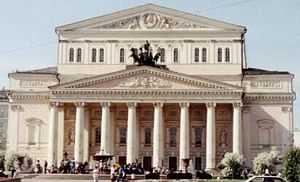
Russian literature is considered to be among the most influential literature in the world. Russia has a rich literary history, beginning with the poet Alexander Pushkin, considered the greatest Russian poet and often described as the "Russian Shakespeare".[56] In the nineteenth century Russian literature underwent an astounding golden age, beginning with the poet Pushkin and culminating in two of the greatest novelists in world literature, Leo Tolstoy and Fyodor Dostoevsky. Russia has remained a leading nation in literature since that time. Significant Russian writers of the Soviet period were Boris Pasternak, Alexander Solzhenitsyn, Vladimir Mayakovski, Mikhail Sholokhov, and the poets Yevgeny Yevtushenko and Andrei Voznesensky. In the field of the novel, Tolstoy and Dostoevsky in particular were titanic figures, and have remained internationally renowned, to the point that many scholars have described one or the other as the greatest novelist ever.[57]
Russia is a large and culturally diverse country with dozens of ethnic groups; each with their own forms of folk music. Music in 19th century Russia was defined by the tension between classical composer Mikhail Glinka and his followers, who embraced a Russian national identity and added religious and folk elements to their compositions, and the Russian Musical Society led by composers Anton and Nikolay Rubinstein, which was musically conservative. The later Romantic tradition of Tchaikovsky was brought into the 20th century by Sergei Rachmaninoff. During the Soviet Era, music was highly scrutinized and kept within certain boundaries of content and innovation; notable composers included Stravinsky, Prokofiev, and Shostakovich.
Russia has a revered and recognised tradition of ballet. Russian composer Pyotr Ilyich Tchaikovsky composed the most famous works of ballet - Swan Lake, The Nutcracker, and Sleeping Beauty. During the early 20th century, Russian dancers Anna Pavlova and Vaslav Nijinsky rose to fame, and Ballets Russes' travels abroad profoundly influenced the development of dance worldwide for decades to come.[58] Soviet ballet continued the 19th-century traditions,[58] and the Bolshoi Ballet in Moscow and the Kirov in St. Petersburg remain famous throughout the world.[58]
Russian filmmaking came to prominence during the 1920s when it explored editing as the primary mode of cinematic expression, resulted in world-renowned films such as Battleship Potemkin. This outburst of creativity and innovation was short-lived, however. In the 1930s, Soviet censorship stifled creativity, though it did produce the hit Chapaev. Later Soviet-era filmmakers, most notably Sergei Eisenstein and Andrei Tarkovsky, would become some of the world's most innovative and influential directors. Russian cinema has been transformed since the dissolution of the Soviet Union. During the 1990s, Russian filmmaking decreased sharply, but recent years have brought increased viewership and subsequent prosperity to the industry through exploration of contemporary subjects.
Sports
Russia is a keen sporting country, successful at a number of sports and continuously finishing in the top rankings at the Olympic games. During the Soviet era the team placed first in the total number of medals won at 14 of its 18 appearances;[59] with these performances, the USSR was the dominant Olympic power of its era.[60] Since the Olympic Games in Helsinki in 1952 and continuing today, the Soviet and later Russian athletes never went below third place in the world, in number and gold medals collected at the Summer Olympics. The 1980 Summer Olympic Games were held in Moscow while the 2014 Winter Olympics will be hosted by Sochi. Among the most played sports are football and ice hockey.[61] Where football is played more as a pastime than professionally, Russia's ice hockey team has a long history of traditions and success, and today more than 70 Russians play in the NHL. Figure skating is another popular sport; in the 1960s the Soviet Union rose to become a dominant power in figure skating, especially in pairs skating and ice dancing. At every Winter Olympics from 1964 until the present day, a Soviet or Russian pair has won gold, often considered the longest winning streak in modern sports history. Since the end of the Soviet era tennis has grown in popularity and Russia has produced a number of famous tennis players. Chess is a favourite pastime, and a sport that has been dominated by Russians in the post-war (1945-) era. The winner of the 1948 World Chess Championship, Russian Mikhail Botvinnik, started an era of Soviet dominance in the chess world. Until the end of the Soviet Union, there was only one non-Soviet champion. Other sports widely played in Russia include weightlifting, gymnastics, boxing, wrestling, martial arts, volleyball, basketball and skiing.
See also
Template:Russian topics
ReferencesISBN links support NWE through referral fees
Footnotes
- ↑ From Article 1 of Constitution of Russia: "The names "Russian Federation" and "Russia" shall be equivalent."
- ↑ Russia - MSN Encarta
- ↑ Danilovic, op. cit., p38
- ↑ 4.0 4.1 4.2 4.3 4.4 4.5 4.6 4.7 4.8 4.9 Russia." Britannica Student Encyclopedia. 2007. Encyclopædia Britannica Online. 3 July 2007 <http://www.britannica.com/ebi/article-207542>.
- ↑ "Russia." Britannica Student Encyclopedia. 2007. Encyclopædia Britannica Online. 2 July 2007
- ↑ 6.0 6.1 "Russia." Britannica Student Encyclopedia. 2007. Encyclopædia Britannica Online. 3 July 2007 <http://www.britannica.com/ebi/article-207562>.
- ↑ 7.00 7.01 7.02 7.03 7.04 7.05 7.06 7.07 7.08 7.09 7.10 7.11 CIA World Factbook - Russia
- ↑ EAP Task Force. CONSUMER PROTECTION AND PUBLIC PARTICIPATION IN THE REFORMS OF THE URBAN WATER SUPPLY AND SANITATION IN THE NIS. EXPERT WORKSHOP. 4-5 MARCH 2002, PARIS, FRANCE. Organisation for Economic Co-operation and Development (OECD) - <http://www.oecd.org/dataoecd/16/36/2390771.pdf>
- ↑ 9.0 9.1 U.S. Geological Survey, Fact Sheet: Lake Baikal - A Touchstone for Global Change and Rift Studies
- ↑ "Russia." Britannica Student Encyclopedia. 2007. Encyclopædia Britannica Online. 3 July 2007 <http://www.britannica.com/ebi/article-207539>.
- ↑ 11.0 11.1 "Russia." Britannica Student Encyclopedia. 2007. Encyclopædia Britannica Online. 3 July 2007 <http://www.britannica.com/ebi/article-207540>.
- ↑ "Russia." Encyclopædia Britannica. 2007. Encyclopædia Britannica Online. 7 Aug. 2007 <http://www.britannica.com/eb/article-38584>.
- ↑ Drozdov V. A. et al. (1992). Ecological and Geographical Characteristics of the Coastal Zone of the Black Sea. GeoJournal 27.2, 169-178.
- ↑ Dienekes Pontikos (2004-10-02). Indo-European Origins in Southeast Europe. Anthropological Research Page. Retrieved 2007-07-20.
- ↑ Andrej Belinskij and Heinrich Härke, "The 'Princess' of Ipatovo," in Archeology, Volume 52 Number 2, March/April 1999.
- ↑ Peter Turchin, Historical Dynamics: Why States Rise and Fall, Princeton University Press, 2003, pp. 185–186. ISBN 0691116695.
- ↑ 17.0 17.1 David Christian, A History of Russia, Central Asia and Mongolia, Blackwell Publishing, 1998, pp. 286–288. ISBN 0631208143.
- ↑ Frank Northen Magill, Magill's Literary Annual, 1977 Salem Press, 1977, p. 818. ISBN 0893560774.
- ↑ André Wink, Al-Hind, the Making of the Indo-Islamic World, Brill, 2004, p. 35. ISBN 9004092498.
- ↑ András Róna-Tas, Hungarians and Europe in the Early Middle Ages: An Introduction to Early Hungarian History, Central European University Press, 1999, p. 257. ISBN 9639116483.
- ↑ Daniel H. Frank and Oliver Leaman, History of Jewish Philosophy, Routledge, 1997, p. 196. ISBN 0415080649.
- ↑ Russia from the Varangians to the Bolsheviks - Page 4 by George Arthur. Birkett, Charles Raymond Beazley, Nevill Forbes
- ↑ History of Russia, Early Slavs history, Kievan Rus, Mongol invasion
- ↑ McLae's Guide to Russia
- ↑ The Russian Campaign napoleonguide.com
- ↑ 26.0 26.1 26.2 26.3 26.4 26.5 26.6 26.7 26.8 26.9 "Russia." MSN Encarta. <http://encarta.msn.com/encyclopedia_761569000_20/Russia.html>.
- ↑ Lenin, Vladimir (1917). The State and Revolution.
- ↑ Archive of Lenin's works. marxists.org
- ↑ 29.0 29.1 Union of Soviet Socialist Republics MSN Encarta
- ↑ 30.0 30.1 "Russia." Britannica Student Encyclopedia. 2007. Encyclopædia Britannica Online. 2 July 2007 <http://www.britannica.com/ebi/article-207580>
- ↑ Richman, Sheldon (1981). War Communism to NEP: The Road to Serfdom. The Journal of Libertarian Studies 5 (1): 89-97.
- ↑ Case Study: Soviet Prisoners-of-War (POWs), 1941-42. Gendercide Watch. Retrieved 2007-07-22.
- ↑ "Soviet Casualties and Combat Losses in the Twentieth Century", Greenhill Books, London, 1997, G. F. Krivosheev
- ↑ Christian Streit: Keine Kameraden: Die Wehrmacht und die Sowjetischen Kriegsgefangenen, 1941-1945, Bonn: Dietz (3. Aufl., 1. Aufl. 1978), ISBN 3801250164
- ↑ Osbourne, Andrew, World leaders gather as Russia remembers. The Age
- ↑ Rozhnov, Konstantin, Who won World War II?. BBC. Russian historian Valentin Falin
- ↑ Andreev, EM, et al, Naselenie Sovetskogo Soiuza, 1922-1991. Moscow, Nauka, 1993. ISBN 5-02-013479-1
- ↑ Mark Harrison, The Economics of World War II: Six Great Powers in International Comparison, Cambridge University Press, 1998, p. 291 (ISBN 0521785030), for more information.
- ↑ Wolf, Julie. Mikhail Gorbachev Public Broadcasting Service. "At 54, younger and healthier than his predecessors, the reform-minded Gorbachev was openly critical of Party excesses".
- ↑ 40.00 40.01 40.02 40.03 40.04 40.05 40.06 40.07 40.08 40.09 40.10 [1]. Nuffield Poultry Study Group - Visit to Russia, pg 7
- ↑ Union of Soviet Socialist Republics MSN Encarta, pg 14
- ↑ Russia pays off USSR’s entire debt, sets to become crediting country Pravda.ru - Russian News & Analysis
- ↑ Nicholson, Alex, Russia metals bonanza raises hopes, fears. latimes.com
- ↑ Roaf, James (European II Department, IMF), Corruption in Russia Conference on Post-Election Strategy Moscow, April 5-7, 2000, International Monetary Fund
- ↑ [2] "Furthermore, Khodorkovsky was considered a part of the Yeltsin-era "crony capitalism"—a freewheeling combination of politically active billionaire "oligarchs" and Boris Yeltsin's family members, who are now being purged"
- ↑ Sahadi, Jeanne, Moscow remains the world’s most expensive city while London moves up from fifth to second place. CNNMoney.com
- ↑ (Russian), Стенограмма пресс-конференции Президента России Владимира Путина. Часть I
- ↑ Members APEC Study Center; City University of Hong Kong
- ↑ International Reserves assets1 of the Russian Federation in 2007 The Central Bank of the Russian Federation
- ↑ Russia's GDP to grow by 7% in 2007: IMF russiatoday.ru
- ↑ (Russian), Уровень жизни населения. Federal State Statistics Service
- ↑ Statement by John Lipsky, First Deputy Managing Director of the International Monetary Fund International Monetary Fund, Press Release No. 07/126
- ↑ Russia's foreign debt down 31.3% in Q3 - finance ministry Russian News & Information Agency
- ↑ 54.0 54.1 Stabilization fund of the Russian Federation Russian Ministry of Finance
- ↑ Schofield, James, Russia's oil renaissance. BBC News
- ↑ "Russia." Britannica Student Encyclopedia. 2007. Encyclopædia Britannica Online. 3 July 2007 <http://www.britannica.com/ebi/article-207547>.
- ↑ "Russian literature." Encyclopædia Britannica. 2007. Encyclopædia Britannica Online. 16 July 2007 <http://www.britannica.com/eb/article-29157>.
- ↑ 58.0 58.1 58.2 "Russia." Britannica Student Encyclopedia. 2007. Encyclopædia Britannica Online. 3 July 2007 <http://www.britannica.com/ebi/article-207552>.
- ↑ Summer Olympics Through The Years. Infoplease.com
- ↑ The main game in a dragon's lair Sydney Morning Herald
- ↑ Russian Sport Activities Russia.com
Bibliography
|
Overall histories
Pre-revolutionary Russia
Soviet era
Post-Soviet era
|
Climate
Language
|
External links
- Russia World Fact Book 2007, accessed August 18, 2007.
- Culture of Russia Countries and Their Cultures No-Sa, accessed August 19, 2007.
- Russia Profile - In-depth coverage of international, cultural, business and political events in Russia
- RussiaMap.org - Maps of Russia
- RussiaBlog.org - News & Commentary on current affairs in Russia
- The St.Petersburg Outdoor Train Museum [3]
- Steam Locomotives on Sakhalin Island [4]
Government resources
- Duma - Official site of the parliamentary lower house (Russian)
- Federative Council - Official site of the parliamentary upper house
- Kremlin - Official presidential site
- Gov.ru - Official governmental portal (Russian)
- Russian Federation Today - Official issue of the Federal Assembly (Russian)
- Ministry of Foreign affairs
- Russian Federal Customs Service
- Central Bank of Russia
- World Security Institute's Johnson's Russia List
- Russian News Agency Ria Novosti
- Russian Space Program
Other resources
- Russia photo gallery and city guide
- (Russian) Culture of Russia - with support of Federal Agency for Culture and Cinematography
- Encyclopaedia Britannica's Country Portal site
- BBC Country Profile - Russia
- RussGUS Bibliographic database of German publications on Russia (about 175 000 positions)
- Way to Russia - Guide to Russia
- CIA World Factbook - Russia
- News From Russia
- U.S. State Department Consular Information Sheet: Russia
- Russia Energy Resources and Industry from U.S. Department of Energy
- Russia History Timeline 1533 - 1991
- Russia's State Symbols
| Geographic locale |
|
Template:Countries of the Baltic region Countries of Europe
Albania · Andorra · Armenia2 · Austria · Azerbaijan1 · Belarus · Belgium · Bosnia and Herzegovina · Bulgaria · Croatia · Cyprus2 · Czech Republic · Denmark3 · Estonia · Finland · France3 · Georgia1 · Germany · Greece · Hungary · Iceland · Ireland · Italy · Kazakhstan1 · Latvia · Liechtenstein · Lithuania · Luxembourg · Republic of Macedonia · Malta · Moldova · Monaco · Montenegro · Netherlands3 · Norway3 · Poland · Portugal · Romania · Russia1 · San Marino · Serbia · Slovakia · Slovenia · Spain3 · Sweden · Switzerland · Turkey1 · Ukraine · United Kingdom3 · Vatican City 1 Has majority of its territory in Asia. 2 Entirely in Asia but having socio-political connections with Europe. 3 Has dependencies or similar territories outside Europe. Countries of Asia
Afghanistan · Armenia · Azerbaijan1 · Bahrain · Bangladesh · Bhutan · Brunei · Cambodia · China, People's Republic of · China, Republic of (Taiwan)2 · Cyprus · Egypt3 · Georgia1 · India · Indonesia4 · Iran · Iraq · Israel · Japan · Jordan · Kazakhstan1 · Korea, Democratic People's Republic of · Korea, Republic of · Kuwait · Kyrgyzstan · Laos · Lebanon · Malaysia · Maldives · Mongolia · Myanmar · Nepal · Oman · Pakistan · Philippines · Qatar · Russia1 · Saudi Arabia · Singapore · Sri Lanka · Syria · Tajikistan · Thailand · Timor-Leste (East Timor)4 · Turkey1 · Turkmenistan · United Arab Emirates · Uzbekistan · Vietnam · Yemen3 For dependent and other territories, see Dependent territory and List of unrecognized countries.
1 Partly or significantly in Europe.
2 The Republic of China (Taiwan) is not officially recognized by the United Nations; see Political status of Taiwan. Template:Countries bordering the Black Sea Template:Countries bordering the Caspian Sea |
| International organizations | |||||||||||||||||||||||||||||||||||||||||||||||||||||||||||||||||||||||||||||||||||
Template:Council of Europe
Template:BRIC
Template:Black Sea Naval Co-operation Task Group (BLACKSEAFOR) Member states of the East Asia Summit (EAS)
Potential future members
Template:Organization of the Black Sea Economic Cooperation (BSEC) Template:Shanghai Cooperation Organisation
| |||||||||||||||||||||||||||||||||||||||||||||||||||||||||||||||||||||||||||||||||||
Credits
New World Encyclopedia writers and editors rewrote and completed the Wikipedia article in accordance with New World Encyclopedia standards. This article abides by terms of the Creative Commons CC-by-sa 3.0 License (CC-by-sa), which may be used and disseminated with proper attribution. Credit is due under the terms of this license that can reference both the New World Encyclopedia contributors and the selfless volunteer contributors of the Wikimedia Foundation. To cite this article click here for a list of acceptable citing formats.The history of earlier contributions by wikipedians is accessible to researchers here:
The history of this article since it was imported to New World Encyclopedia:
Note: Some restrictions may apply to use of individual images which are separately licensed.


